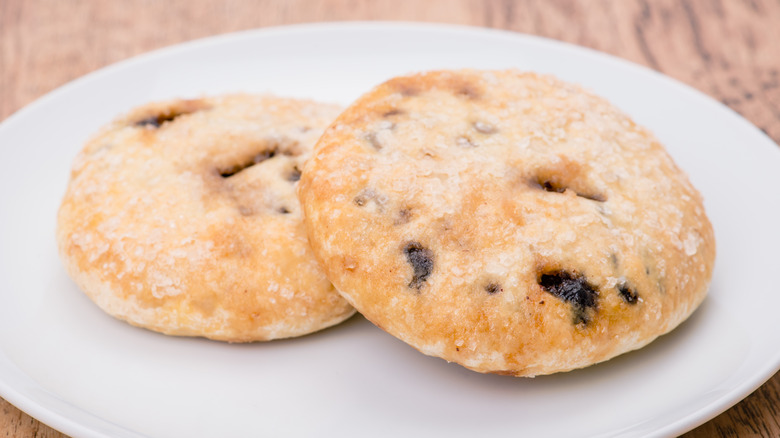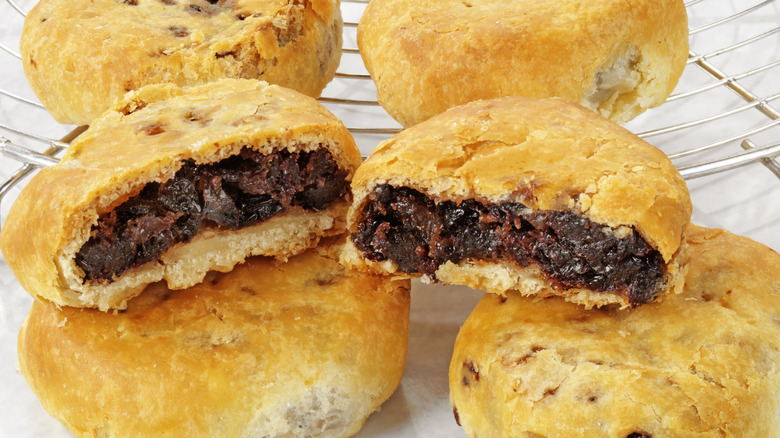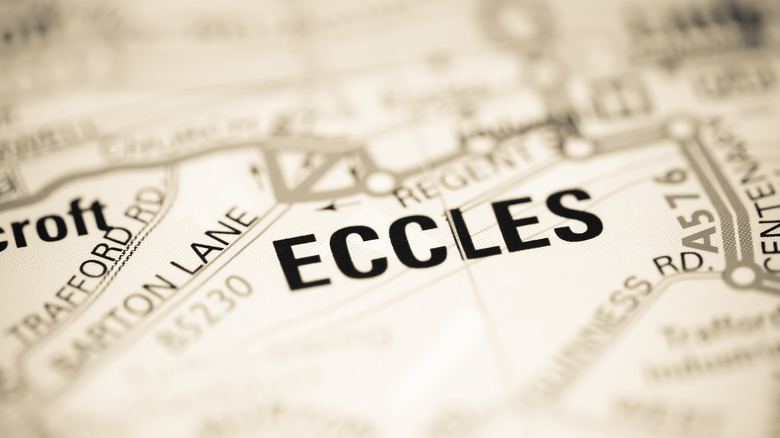English Eccles Cakes, The Spiced Mini Pastries To Soothe Your Soul
If there's anything we've learned from "The Great British Bake Off," it's that the British are as big on desserts as they are on tradition — which is why there are so many unique and delicious sweets that are iconic to Britain — and have been for centuries. One of those traditional, beloved British desserts is the English Eccles cake.
These tiny, tasty pastries are named after the town where they were first sold back in the 17th century, likely in relation to the feast day of Saint Mary in Eccles – and they're still a popular British dish today. They're also known as "squashed fly cakes" – not to be confused with the Scottish fruit slice, aka "fly cemetery." It's not exactly an appetizing nickname, but fitting nonetheless due to the soft black currants that take up residence inside their crust.
Similar to a hand pie or a turnover, an Eccles cake is a small, round treat with a crust made of flaky, buttery pastry. It's filled in the middle with a mixture of warmly spiced, citrusy dried currants, then coated in sugar and baked until golden brown. A little sweet, a little sour, a little sticky ... and a lot scrumptious.
Everything that goes into an Eccles cake
Traditional Eccles cakes are technically made with flaky pastry, which is slightly different from puff pastry. Flaky pastry requires less fat (aka butter or lard) and has fewer layers than puff pastry, meaning the dough isn't folded as many times. Think of it as a cross between puff pastry and an all-purpose pie crust. The result is still a light, buttery, crispy crust that has a bit more structure and doesn't rise quite as much as puff pastry.
But everything people love about Eccles cakes lies in the filling. The main ingredient is dried currants; these are similar to raisins in that they are both dried grapes, but currants have a tangier, more intense flavor. To make that magic in the center of the small pie, the dried currants are mixed with butter, sugar, lemon, and orange peel (either fresh or candied), and warm spices like nutmeg, cinnamon, ginger, and allspice.
Brushed with egg wash and dusted with sugar like flaky demerara, the mini delicacies are baked until crispy, golden, and slightly sticky. They can be eaten warm or cold, but if served the traditional way, they'll be accompanied by a wedge of sharp English cheese and a cup of tea.
The complicated history of the Eccles cake
It turns out that Eccles cakes have quite the backstory, and have gotten into a bit of trouble over the years. The town of Eccles in Lancashire, England, held religious festivals called Eccles Wakes — where the church community most likely enjoyed the soul-soothing sweetness of Eccles cakes while they danced and sang.
But because of their connection to the feast day of Saint Mary, and what the Puritans considered some form of debauchery at these religious festivals, Eccles cakes were actually (one of the many things) banned in the 1600s. Luckily, that didn't stop the town members from continuing to bake and enjoy the tiny treats until the ban was eventually lifted, and they were able to be sold and circulated freely again.
More recently, Eccles cakes have run into a different sort of trouble — not the Puritan threat of fiery hell, but actual fire. In 2013, the Lancashire Fire and Rescue Service issued a warning in regard to the pastries because there were reports of three fires in three weeks ... from microwaving Eccles cakes. Supposedly, the sugar on the outer crust can burst into flames, so you may want to opt for the oven if you're warming some up. This is also the traditional way of reheating the pastry, which prevents it from becoming soggy.



